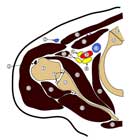|

|
Synonyms: Posterosuperior glenoid impingement, internal impingement
Internal Impingement ICD-10
Internal Impingement ICD-9
Internal Impingement Etiology / Epidemiology / Natural History
- Definition: abnormal contact bewteen the rotator cuff undersurface and the posterosuperior glenoid rim, resulting in tearing of the rotator cuff and labrum. (McMahon PJ, OKU08, 2005).
- Contact between the supraspinatus or infraspinatus tendon and posterior-superior glenoid rim with the shoulder in the cocked, throwing position of 90° of abduction and maximum external rotation can lead to undersurface tears of RC and lesions of posterosuperior labrum.
- Impingement occurs during the late-cocking phase of throwning.
- It is unknown whether the pain produced is due to tension on the tendon, contact of the tendon with the glenoid, or deformation of the labrum or cartilage by the rotator cuff tendon.
Internal Impingement Anatomy
- Eighty-five percent of the patients make contact between the rotator cuff and glenoid rim at an average of 95° of abduction and 74° of external rotation. (McFarland EG, JSES, 1999;8:458 ).
- Excessive ER and humeral extension associated with throwing causes impingement of the undersurface of the rotator cuff on the posterosuperior glenoid labrum. (Crockett HC, AJSM 2002;30:20).
- Supraspinatus may impinge on the posterior superior aspect of the glenoid with abduction and external rotation. (Walch G,JSES 1992;1:238).
- RTC may impinge on the glenoid in flexion (Kim TK,CORR 2004;421:112)
- The RTC can contact the coracoid with the arm in flexion and internal rotation. (Dines DM, JBJS 1990;72Br:314) (Gerber C, JBJS 1985;67Br:703) (Lo IK, Arthroscopy. 2003;19:1068)
- The largest concenontration of pain fibers in the shoulder is in the bursa, followed by the rotator cuff tendon and the biceps tendon. (Soifer TB, Arthroscopy. 1996;12:182).
- See also Shoulder Anatomy.
Internal Impingement Clinical Evaluation
- Posterior shoulder pain generally in overhead athletes, generally during the acceleration phase of throwing.
- Decreased internal rotation; increased external rotation.
- Internal Impingement Sign: posterosuperior shoulder pain with arm in maximal external at 90° abduction . Anterior pain indicates anterior instability, posterosuperior pain indicates internal impingement. (sensitivity=75.5%, specificity=85%; Meister K, AM J Orthopedics 2004;33:412)
- Anterior apprehension test causes posterior shoulder pain which is relieved with the relocation test.
- Often have postive impingement signs: Neer, Hawkins.
Internal Impingement Xray / Diagnositc Tests
- AP, scapular lateral and axillary views generally normal. May show cystic and sclerotic changes in the greater tuberosity or rounding of the posterior glenoid rim.
- MRI: may show partial undersurface RTC tearing or tendinosis involving the posterior supraspinatus/infraspinatus, cystic changes in greater tuberosity, glenoid sclerosis, humeral head edema/articular erosion near the greater tuberosity.
Internal Impingement Classification / Treatment
- Posterior capsular stretching, physical therapy focused on improving dynamic shoulder stabilizers, activity modifications. In baseball pitchers adjust throwing mechanics to avoid extension beyond the plane of the scapula during the the cocking phase and most of the acceleration phase of throwing.
- Shoulder Arthroscopy: indicated only in patients who fail to improve with appropriate non-operatvie treatment. Consider debridement vs repair of any labral or RTC lesions with posterior capsular release for patients with interal rotation deficit. Consider anterior capsule tightening for patients with anterior laxity.
- Humeral Derotational osteotomy: indicated only for failure of non-op and arthscopic treatment. Goal = humeral retroverison of 30°. High complication rate, need for HWR.
Internal Impingement Associated Injuries / Differential Diagnosis
- RTC tear
- SLAP tear
- Posterior Capsular Contracture:
- Quadrilateral Space Syndrome
- Posterior Instability
- Posterior labral pathology
- Teres minor strain
- Long thoracic nerve palsy
- Suprascapular nerve palsy
- Osteochondritis dissecans
Internal Impingement Complications
- Recurrence / failure
- Hardware failure / Anchor pull-out
- Infections
- Stiffness
- CRPS
- Nerve injury: Axillary nerve, Brachial plexus
- Fluid Extravasation:
- Chondrolysis: though to be related to heat from electo cautery or radiofrequency probes used during capsular release or capsular shrinkage.
- Hematoma
- Chondral Injury / arthritis
- Instrument failure
Internal Impingement Follow-up Care
- Post-operative care must be adjusted for any assoicated injuries. In general:
- 0-6weeks: PT focused on passive shoulder ROM, active elbow/wrist/hand ROM. Isometric exercises with the arm at the side in neutral rotation.
- 6-12 weeks: strengthening / proprioception. Full functinoal ROM should be achieved by 8 weeks.
- 12-16 weeks: Sport specific activities.
- 16 weeks: Return to sports including interval throwing program and advance to competitive throwing.
- See also Shoulder Outcome Measures.
Internal Impingement Review References
|

